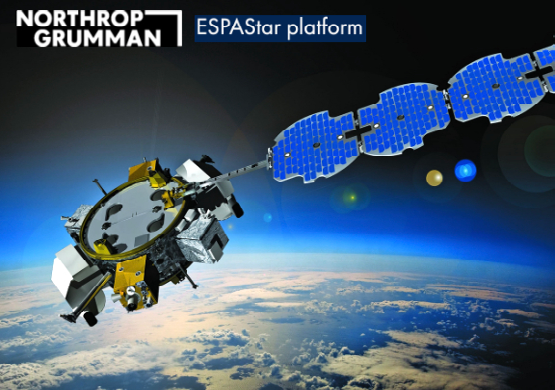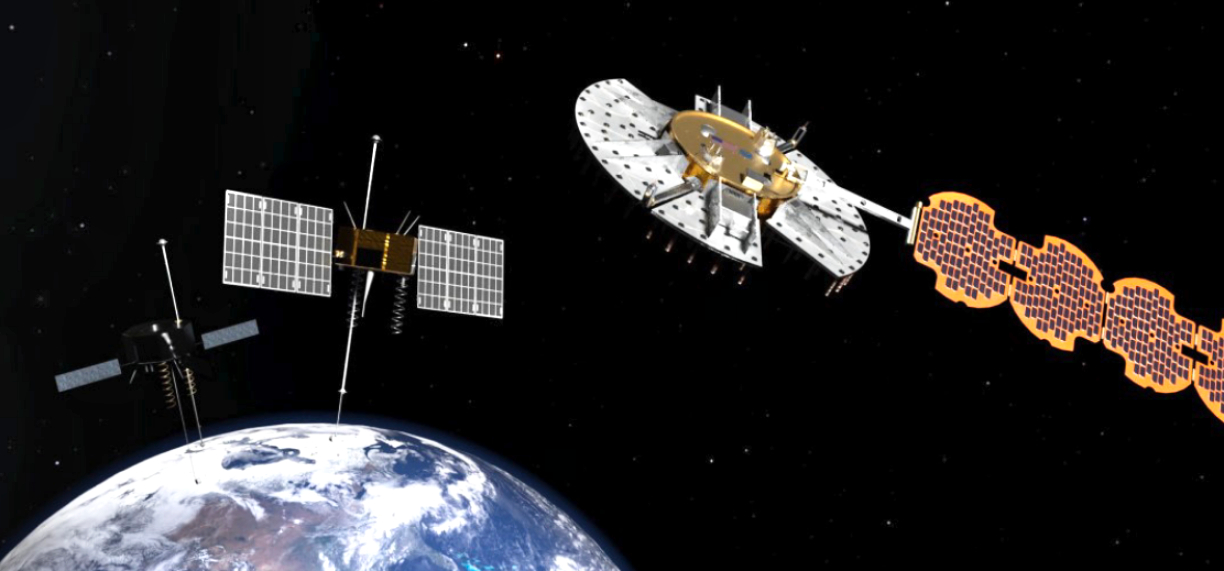Navigation Technology Satellite-3 (NTS-3)
The U.S. Space Force’s Global Positioning System (GPS) constellation provides unprecedented position and timing accuracy to the warfighter. Since the inception of GPS, it has become a global utility with commercial use far outweighing military use. Air traffic control, banking, farming, and cellular networks all depend on uninterrupted GPS coverage.

Artistic rendition of NTS-3 in GEO. Image credit: 1st Lt. Jacob Lutz
Set to launch in 2023, NTS-3, America’s next experimental navigation satellite, will push the boundary of today’s position, navigation, and timing (PNT) technology to pave the way for a more flexible, robust, and resilient architecture for satellite navigation technology.
AFRl’S PNT Frontier

L3Harris will integrate NTS-3 using Northrop Grumman’s ESPAStar
bus, building on EAGLE’s flight heritage.
Together with industry, the Air Force Research Laboratory (AFRL) is developing advanced techniques and technologies to detect and mitigate interference to PNT capabilities and increase system resiliency for military, civil, and commercial users. To test these new capabilities in hardware, software and concepts of operations, NTS-3 will operate for one year in Geosynchronous Earth Orbit (GEO). Ultimately, NTS-3 will identify key aspects for new GPS receivers that incorporate multiple signals and readily adapt to warfighter needs.
tIn 2019, the U.S. Air Force designated NTS-3 as one of three Vanguard programs, priority initiatives that integrate several technology components to deliver new game-changing capabilities, covering multiple domains and encompassing multidisciplinary solutions. Marked by enterprise commitment, Vanguard programs aim to deliver game-changing capabilities rapidly that transform future operations with cutting-edge technologies. The prototype demonstration of NTS-3 will involve a space-based test vehicle, ground based command and control, and agile software defined radios for the user. In particular, NTS-3 will experiment with multiple integrated advanced technologies including electronically steered phased array antennas, flexible and secure signals, software-defined GPS receivers, increased ground control segment (GCS) automation, and use of commercial ground antennas.
Giving PNT Signals a Suit of Armor
NTS-3 will test a new digital signal generator that can be reprogrammed on- orbit, enabling it to broadcast new signals, improve performance by avoiding and defeating interference, and adding signatures to counter spoofing.
AFRL will explore antenna configurations to provide Earth coverage and steerable regional beams in multiple frequencies and signal codes. Ultimately, NTS-3 will provide users with enhanced signal stability, availability, integrity and accuracy.

NTS-1, NTS-2, and NTS-3. Graphic Credit: 1st Lt. Jacob Lutz
“Bounce-Back” Capabilities
The space environment poses a persistent challenge to our on-orbit capabilities. Orbits degrade, the Van Allen belts bathe spacecraft with radiation, and solar flares affect the ionosphere. The space and frequency domains are increasingly congested and competitive with the addition of foreign navigation constellations and commercial broadband mega-constellations. Therefore, ensuring that PNT signals are viable, even with interruption or interference, is crucial to system operability and availability.
——————————————————
The Long Line of Navigation Technology
• 1974: NTS-1 launched with new standards that advance timing and navigation precision
• 1977: NTS-2 launched as the first NAVSTAR GPS
Phase 1 satellite
• 2023: Anticipated launch of NTS-3, the first experimental PNT spacecraft in more than 40 years
————————————————————————
Specific improvements to the ground segment will enable experimentation with automated “lights-out” operations, control station failover, and near-real time environment sensing and generation of error correction and tailored waveforms. On-board systems will monitor clock accuracy and orbit parameters to mitigate errors and notify the user.
Planned resilience experiments emphasize maintaining accurate timing and position knowledge following loss of contact with ground control, maintaining user position accuracy following satellite maneuvers, and detection and correction of a timing or signal anomaly. Resilience will be enabled in part by the improvement of on-board signal integrity detection and user notification. Data collected throughout on-orbit operations will inform the design of next- generation PNT satellites.
A new era in Ground control
The NTS-3 GCS is compatible with the Enterprise Ground Services (EGS), an architecture that the Space Systems Command (SSC) is developing to provide a common system for satellite command and control. The goal is to move from a portfolio of stove piped ground systems to a single system that will connect with all Air Force and Space Force satellites, saving millions of dollars by streamlining user training and operations.
EGS will leverage big data and facilitate easier data sharing, situational awareness, and collaboration. The NTS-3 GCS will be backwards compatible with legacy ground systems, incorporate signal monitoring data from diverse sources, and leverage commercial antenna networks to maintain short-notice on-demand satellite control capability.
A User-Friendly Experience

To ensure that user receiver equipment integrates seamlessly, the program team is developing software-defined PNT receivers that can rapidly respond to changing conditions. Like the on-orbit signal generator, the receivers are reprogrammable, thus increasing security and flexibility. They will readily adapt to warfighter needs and incorporate signals from the Galileo, QZSS, and other allied constellations since the experiment results and technology in NTS-3 will ultimately transition to the national space community.
www.afrl.af.mil

